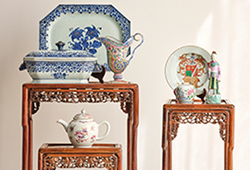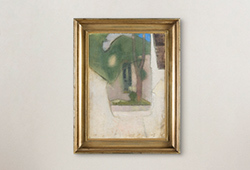Altarbord, zitan, med infällda plaketter av cloisonné. Qingdynastin, Qianlong (1736-95).
Avlång rektangulär top med tre breda panel av trä i en ram, sidorna fint skurna i relief, med åtta infällda förgyllda cloisonné plaketter. Längd 114,5 cm. Höjd 76 cm. Djup 48 cm.
Restaurerad.
Proveniens
From the Collection of Klas E Böök (1909-1980), thence by descent. A Swedish diplomat and civil servant. Mr Böök first had a career within banking, that led up to the position of Governor of the Swedish National Bank from 1948 to 1951. His diplomatic career began when he was appointed head of the Commercial Department of the Ministry for Foreign Affairs and envoy from 1947 to 1948. He was minister in Ottawa from 1951 to 1956, ambassador in Beijing from 1956 to 1961, also accredited as envoy to Bangkok from 1956 to 1959. Böök was ambassador in New Delhi, also accredited to Colombo and Kathmandu from 1961 to 1965 and in Bern from 1965 to 1972. He had special assignments for the Foreign Ministry from 1972 to 1975.
Utställningar
The black and white images is of the table in Mr Bööks residence in New Dehli, when ambassador there.
Image of the chair in the same home in India.
Image of Mr Böök and Zhou Enlai (1898-1976) Chinese statesman who served as the first Premier of the People's Republic of China from September 1954 until 1976.
Litteratur
Compare a table at Christies Imperial Sale 2861, lot no 3607, 2011. Also with Cloisonné placques.
The technique of embellishing furniture with archaistic white jade bi-discs and/or cloisonne enamel plaques, normally through a design that implies these elements have been attached by ropes, appears to be a popular form of decoration. See an example of a black lacquered kang table, decorated with circular cloisonne enamel plaques, illustrated by Hu Desheng, The Palace Collection: A Treasury of Ming & Qing Dynasty Palace Furniture, vol. 1, Forbidden City Publishing House, 2007, p. 240, fig. 271 (see fig. 1). A zitan incense stand inset with cloisonne enamel is also illustrated, ibid., p. 278, fig. 319.
Compare also; Classic Chinese Furniture of the Qing dynasty, Tian Jiaqing, Hong Kong 1995, a zitan cloisonne mounted throne chair, lot 50, page 129. Also an Zitan enamel inlay foot stool is depicted.
Qing Gongting jia ju zhen da guan, Beijing, 2006. Also compare a an armchair and a garden seat in Zitan enamel inlay depicted on page 154,114.
Övrig information
Unusual with such wide aprons, it would get the table a higher weight bearing capacity. Could have been used as a display stand for heavy objects such as scholars rock, bronzes or heavy porcelain vessels.
It is decorated to all sides, and made to stand freely in a room. It is also likely that it made for playing a Qin.
Prospective purchasers are advised that several countries prohibit the importation of property containing materials from Zitan. Accordingly, prospective purchasers should familiarize themselves with relevant customs regulations prior to bidding if they intend to import this lot into another country.























































































